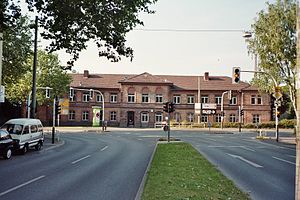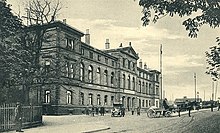Bochum Nord train station
| Bochum North | |
|---|---|
 Bochum Nord train station
|
|
| Data | |
| Location in the network | Separation station |
| abbreviation | EBNO |
| location | |
| City / municipality | Bochum |
| country | North Rhine-Westphalia |
| Country | Germany |
| Coordinates | 51 ° 28 '58 " N , 7 ° 13' 31" E |
| Railway lines | |
| Railway stations in North Rhine-Westphalia | |
The Bochum-Nord station is today Ostring in Bochum and has long served the passenger and freight transport on the railway line Osterath-Dortmund South , which in 1874 by the Rhenish Railway Company was opened. Passenger traffic was discontinued in 1979, the freight yard is the location of the main customs office of the city of Bochum.
history
Originally called "Rheinischer Bahnhof" or "Bochum Rheinisch", the station was laid out between 1871 and 1874 and opened on October 15, 1874. On the north side of the station area, a depot with an eleven-hour roundhouse was built, which is still partially preserved today.
After the nationalization of the private railway companies around 1880, passenger traffic on the Rhenish route lost its importance compared to that on the Bergisch-Märkische Bahn , while goods traffic through the connected mines and steelworks continued to grow. In 1883 the station was connected to the Ruhr Valley Railway in Dahlhausen by a connection to Weitmar via the Essen-Überruhr – Bochum-Langendreer railway line . In addition to the Victoria Brewery , whose siding crossed Blumenstrasse, there was also a works railway, which was later extended northwards across the premises of the Bochum steelworks to the shafts of the Lothringen colliery in Bochum-Gerthe .
The lines of the Rheinische and Bergisch-Märkische Bahn running next to each other between Bochum and Dortmund-Dorstfeld were rebuilt around 1908 so that the passenger traffic could be separated from the slower freight traffic. To the east of the Bochum Nord train station, several overpass structures from this period, which are now only partially used, have been preserved - as well as the road bridge between Lohring and Harpener Straße directly at the east end of the train station, which is intended to be demolished. After the First World War, the passenger route on the northern route of the former Rheinische Bahn was further expanded.
In the time of National Socialism , the deportations of Jewish citizens usually took place via the North Station.
In 1959 the depot was given up.
In 1979 the station was closed to passenger traffic. The train connections on the former Rheinische Eisenbahn (Langendreer-Bochum-President) were omitted, the train connections over the railway line Bochum-Gelsenkirchen (to Herne , Wanne-Eickel or Gelsenkirchen ) were made by the construction of a new connection curve, which the Konrad-Adenauer-Platz in Bochum Bermuda3eck bridged, connected to Bochum main station.
Reception building
The station building from 1874, which was larger than comparable buildings to accommodate additional offices for the railway company, lost the entire second floor after the Second World War. Since passenger traffic was discontinued in 1979, it was used for a long time as an office building by Deutsche Bundesbahn offices. In the interior, stairs and other details from the construction period are still partially preserved despite renovations. The architectural historian and monument conservator Hans Hanke, chairman of the Kortumgesellschaft Bochum , wrote about the building: “Anyone who has seen the house from the inside will have enjoyed the cast-iron pillars, the beautiful staircase and the pretty floors. The station building from 1874 is still impressively preserved here. ”The attempt to place the building under monument protection failed in 1997.
The Moritz Fiege private brewery acquired the reception building in 2000. Fiege hoped for possible uses in the form of restaurants and lawyers' offices, as the new justice center was planned to be in the immediate vicinity.
In the summer of 2015, the Moritz Fiege private brewery applied for the building to be demolished, as concealed construction defects (e.g. in the ground floor built into the rear of the embankment) led to greatly increased renovation costs and, in their view, no economic use was possible. There was public resistance to a demolition. In the opinion of those opposed to the demolition, the building must be preserved because of its monument value, ie because of its importance for Bochum's city history . The building was eventually sold to a private investor who, despite the renovation costs, considered a similar use to be economically viable.
Upper floor hallway, groin vault and fluted columns with Corinthian capitals (2016)
Ornament tiles in the counter hall (2016)
literature
- Hans H. Hanke: The train hasn't left yet. Reports on the north station. In: Bochumer Punkte , issue 35 (February 2016), pages 3–15.
- Jörg Hajt: Railways in the central Ruhr area. Kenning, Nordhorn 1994, ISBN 3-927587-19-2 .
Web links
- Description of this sight on the route of industrial culture
- Description of the EBNO operating point in the NRWbahnarchiv by André Joost
- Film report about the north station
- Bochum-Nord at the Eisenbahnfreunde Lette
Individual evidence
- ↑ http://www.coolibri.de/redaktion/aktuelles/0815/abriss-nordbahnhof-bochum.html
- ↑ http://www.radiobochum.de/bochum/lokalnachrichten/lokalnachrichten/archive/2015/08/13/article/-ad5e43e662.html
- ↑ http://www.coolibri.de/redaktion/aktuelles/0815/abriss-nordbahnhof-bochum.html
- ↑ http://www.derwesten.de/staedte/bochum/bochum-will-mit-der-innenstadt-als-neues-pfund-wuchern-id573038.html
- ↑ http://www.bo-alternativ.de/2015/08/22/spekulation-um-den-nordbahnhof/







